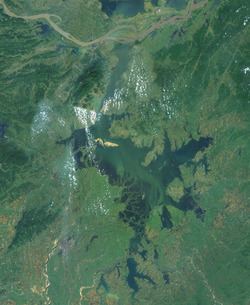Max. width 17 kilometres (11 mi) Area 4,400 km² Catchment area 162,225 km² Province Jiangxi | Max depth 25 m Surface elevation 16 m Width 17 km | |
 | ||
Primary inflows Max. length 170 kilometres (110 mi) Surface area 3,210 square kilometres (1,240 sq mi) | ||
The poyang lake disaster how china s largest lake dried up
Poyang Lake (Chinese: 鄱阳湖/鄱陽湖; pinyin: Póyáng Hú, Gan: Po-yong U), located in Jiangxi Province, is the largest freshwater lake in China.
Contents
- The poyang lake disaster how china s largest lake dried up
- Map of Poyang Lake China
- The bermuda triangle of the east mystery the laoye temple waters of poyang lake
- Formation
- Loss of Wildlife
- Shrinkage
- In history
- References
Map of Poyang Lake, China
The lake is fed by the Gan, Xin, and Xiu rivers, which connect to the Yangtze through a channel.
The area of Poyang Lake fluctuates dramatically between the wet and dry seasons, but in recent years the size of the lake has been decreasing overall. In a normal year the area of the lake averages 3,500 square kilometres (1,400 sq mi). In early 2012, due to drought, sand quarrying, and the practice of storing water at the Three Gorges Dam the area of the lake reached a low of about 200 square kilometres (77 sq mi). The lake provides a habitat for half a million migratory birds and is a favorite destination for birding.
During the winter, the lake becomes home to a large number of migrating Siberian cranes, up to 90% of which spend the winter there.
The bermuda triangle of the east mystery the laoye temple waters of poyang lake
Formation
Poyang Lake has also been called Pengli Marsh (彭蠡澤) historically, but they are not the same. Before the Han Dynasty, the Yangtze followed a more northerly course through what is now Longgan Lake whilst Pengli Marsh formed the lower reaches of the Gan River. The area that is now Poyang Lake was a plain along the Gan River. Around 400 AD, the Yangtze River switched to a more southerly course, causing the Gan River to back up and form Lake Poyang. The backing up of the Gan River drowned Poyang County and Haihun County, forcing a mass migration to Wucheng Township in what is now Yongxiu County. Wucheng thus became one of the great ancient townships of Jiangxi Province. This migration gave birth to the phrase, "Drowning Haihun County gives rise to Wucheng Township" (Chinese: 淹了海昏縣,出了吳城鎮).
Lake Poyang reached its greatest size during the Tang Dynasty, when its area reached 6,000 square kilometres (2,300 sq mi).
Loss of Wildlife
There has been a fishing ban in place since 2002.
In 2007 fears were expressed that China's finless porpoise, known locally as the jiangzhu ("river pig"), a native of the lake, might follow the baiji, the Yangtze river dolphin, into extinction.
Calls have been made for action to be taken to save the porpoise, of which there are about 1,400 left living, with between 700 and 900 in the Yangtze, with about another 500 in Poyang and Dongting Lakes.
2007 population levels are less than half the 1997 levels, and the population is dropping at a rate of 7.3 per cent per year.
Sand dredging has become a mainstay of local economic development in the last few years, and is an important source of revenue in the region that borders Poyang Lake. But at the same time, high-density dredging projects have been the principal cause of the death of the local wildlife population.
Dredging makes the waters of the lake muddier, and the porpoises cannot see as far as they once could, and have to rely on their highly developed sonar systems to avoid obstacles and look for food. Large ships enter and leave the lake at the rate of two a minute and such a high density of shipping means the porpoises have difficulty hearing their food, and also cannot swim freely from one bank to the other.
Shrinkage
Due to the Three Gorges Dam upriver on the Yangtze river, Poyang Lake can shrink and dry up for portions of the year.
In 2016, the lake nearly dried up completely. 200 square kilometers of land was underwater in October, while the lake is normally 3,500 square kilometers in area when full. In addition to the Three Gorges Dam, which must store water in its reservoir to be used in the winter, a drought was also blamed for the shrinkage.
The Jiangxi local government has proposed to build the Poyang Lake Dam to maintain water levels in the lake, building a sluice wall across the connection between the lake and the Yangtze river. An environmental impact assessment is pending. Scientists, as well as environmental groups such as the World Wildlife Fund, have criticised the proposal, arguing that artificially engineering water levels in the lake will adversely affect wildlife diversity.
In history
In 1363, the Battle of Lake Poyang took place there, and it is claimed to be the largest naval battle in history.
The lake has also been described as the "Chinese Bermuda Triangle". Many ships have disappeared while sailing in it. On 16 April 1945, an Imperial Japanese Navy ship, which carried loot from the Japanese Occupation of China vanished without a trace with 200 sailors.
